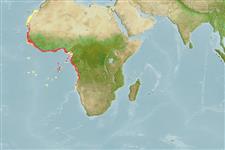>
Gadiformes (Cods) >
Merlucciidae (Merluccid hakes)
Etymology: Merluccius: Latin, mar, maris = the sea + Latin, lucius = pike (Ref. 45335).
Environment: milieu / climate zone / depth range / distribution range
Ökologie
seewasser bathydemersal; standorttreu; tiefenbereich 50 - 1248 m (Ref. 112558), usually 50 - 550 m (Ref. 58452). Deep-water; 29°N - 19°S, 19°W - 15°E (Ref. 58452)
Eastern Atlantic: off the coast of tropical West Africa, from Mauritania to Angola. Range reported to extend to off southwest Africa near Cape Frio, Namibia (Ref. 6524).
Length at first maturity / Size / Gewicht / Alter
Maturity: Lm 44.4 range ? - ? cm
Max length : 80.0 cm TL Männchen/unbestimmt; (Ref. 1371); common length : 40.0 cm TL Männchen/unbestimmt; (Ref. 26999)
Kurzbeschreibung
Morphologie | Morphometrie
Rückenflossenstacheln (insgesamt): 1; Rückenflossenweichstrahlen (insgesamt): 45-52. Head large and little depressed. Pectoral fin tips usually reaching the origin of anal fin in small but not in large individuals. Scales easily shed. Color usually blackish on back, steel gray to blackish on belly; caudal fin white-edged.
Feeds mainly on small fishes and partly on squids and shrimps (Ref. 1371). Marketed mostly fresh and frozen, also used for fishmeal and oil (Ref. 1371). Minimum depth reported taken from Ref. 1371.
Life cycle and mating behavior
Geschlechtsreife | Fortpflanzung | Ablaichen | Eier | Fecundity | Larven
Cohen, D.M., T. Inada, T. Iwamoto and N. Scialabba, 1990. FAO species catalogue. Vol. 10. Gadiform fishes of the world (Order Gadiformes). An annotated and illustrated catalogue of cods, hakes, grenadiers and other gadiform fishes known to date. FAO Fish. Synop. 125(10). Rome: FAO. 442 p. (Ref. 1371)
IUCN Rote Liste Status (Ref. 130435)
Bedrohung für Menschen
Harmless
Nutzung durch Menschen
Fischereien: weniger kommerziell
Mehr Information
ReferenzenAquakulturAquakultur ProfilZuchtlinienGenetikElectrophoresesVererbbarkeitKrankheitenVerarbeitungNutrientsMass conversion
Tools
Zusatzinformationen
Download XML
Internet Quellen
Estimates based on models
Preferred temperature (Ref.
123201): 7.3 - 19.8, mean 14.2 °C (based on 93 cells).
Phylogenetic diversity index (Ref.
82804): PD
50 = 0.5000 [Uniqueness, from 0.5 = low to 2.0 = high].
Bayesian length-weight: a=0.00447 (0.00243 - 0.00821), b=3.09 (2.93 - 3.25), in cm total length, based on LWR estimates for this Genus-body shape (Ref.
93245).
Trophic level (Ref.
69278): 4.5 ±0.63 se; based on food items.
Generation time: 2.8 ( na - na) years. Estimated as median ln(3)/K based on 1
growth studies.
Widerstandsfähigkeit (Ref.
120179): mittel, Verdopplung der Population dauert 1,4 - 4,4 Jahre. (K=0.39(?); assuming tm>=2).
Fishing Vulnerability (Ref.
59153): Low to moderate vulnerability (35 of 100).
Climate Vulnerability (Ref.
125649): High vulnerability (58 of 100).
Nutrients (Ref.
124155): Calcium = 11.3 [5.5, 40.8] mg/100g; Iron = 0.351 [0.069, 0.938] mg/100g; Protein = 17.3 [16.0, 18.5] %; Omega3 = 0.158 [0.081, 0.306] g/100g; Selenium = 28.7 [12.1, 62.7] μg/100g; VitaminA = 9.7 [1.9, 42.7] μg/100g; Zinc = 0.203 [0.137, 0.312] mg/100g (wet weight);
